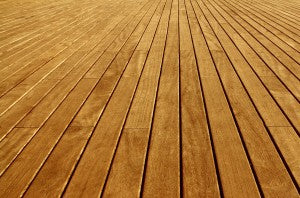If you suffer with an allergy, then replacing carpet with hard flooring could be a good investment in your health. Carpet can be a reservoir for house dust mite, which produces one of the most powerful allergens. However, when selecting a wood floor, be careful that you are not exchanging one health problem for another. Cheap wood flooring (and sometimes expensive wood floors) can give off formaldehyde, a volatile organic compound (VOC) which is classified as a carcinogen (chemical linked to cancer) by the International Agency for Research on Cancer.
Formaldehyde is off-gased from medium density fibreboard (MDF), a cheap alternative to natural wood. But even high-end engineered wood floors may consist partly out of MDF to prevent the actual wood from changing shape. MDF is simply a manufactured sheet material made by bonding together wood fibres with a glue. It is very versatile, used for floors and for all kinds of furniture applications.
The adhesive used to bind MDF together can be one of the following:
• Urea-formaldehyde
• Phenolic resin
• Melamine urea-formaldehyde
• Polymeric diphenylmethanediisocyanate (PMDI)
If machining or sanding MDF board you expose yourself to dust particles on which formaldehyde has been absorbed, as well as to free formaldehyde in the surrounding air. Once your new floor is fitted, be aware that formaldehyde can outgas from it, into the atmosphere, for a period of many months (but only, of course, if it actually contains a formaldehyde adhesive). You will find that if you use under-floor heading, the off-gassing will be higher when the floor is getting warmed up.
Formaldehyde is a simple volatile organic chemical that occurs naturally as well as being found in many products other than MDF and furniture, such as toiletries, plastics, carpets and clothing. Naturally occurring formaldehyde levels are normally not more than 0.03 parts per million (ppm), which should not pose a health risk. However, inside homes or offices containing formaldehyde-emitting products levels may rise above this.
The Health and Safety Executive (HSE) in the UK sets limits to exposures to formaldehyde for those working with MDF and other formaldehyde-containing products. These are known as workplace exposure limits (WEL). The WEL for both long-term (8 hours) and short term (15 minute) exposures are 2 ppm.
For those having a new wood floor fitted in their home, it is perhaps more relevant to shop carefully for their MDF or hard wood floors that in part consist of MDF. Board manufactured in Europe must meet EU standards. There are two European formaldehyde classes, known as E1 and E2. Levels of emission from E1 board is less than 0.1ppm and from E2 boards it is between 0.1 and 0.3 ppm. In Europe, most manufacturers produce E1 boards or may be marked 'no added formaldehyde' if they are made with a non-formaldehyde binder like PMDI. They should always carry a CE mark listing characteristics and whether they are E1 or E2. To comply with the standard, formaldehyde levels of the product have to be tested on a regular basis.
The danger lies in MDF boards made outside the EU and imported here, which may have higher emissions. Here there is no real regulatory control although there are a number of 'third party' labelling schemes, not properly addressing wood floors and formaldehyde. The first organisation to regulate formaldehyde was the Californian Air Resources Board (CARB) scheme, which has been involved in a recent case of excess formaldehyde emitted from boards imported to the United States from China.
Therefore, to protect yourself, do shop carefully for your MDF. Look for the CE label and opt for one made with a non-formaldehyde binder or one marked E1. Beware unlabelled board from a cheap shop or warehouse! If you are doing the wood flooring yourself, make sure the area is well ventilated and wear a high quality mask when working with the MDF. A good allergy vacuum cleaner fitted with a high efficiency air purifier (HEPA) filter should be used to clean up MDF dust to save breathing it in. If someone else is doing the work, watch out for any allergy symptoms caused by formaldehyde exposure when you come back into the property – such as headaches, sore eyes and so on. Remember, this exposure could last for months and do long-term damage to your health. It is also worthwhile storing any formaldehyde-containing MDF for a week or two in a dry place before working with them, and allowing the peak period of outgassing to pass by. Board enclosed in laminate is safer, and exposed areas where outgassing could occur should be covered by layers of paint or varnish.
Once the wooden floors are in your home, and you experience elevated levels chemical and gases, consider cleaning the air with a high efficiency gas and chemical air purifier such as the IQAir GC MultiGas.
I'm getting rid of carpet in my own property over the next few months and will replace with a hard floor. I've been noticing how many flooring shops there are around. Good that there is lots of choice, but I'll certainly be carefully comparing the options before deciding which MDF to purchase.




